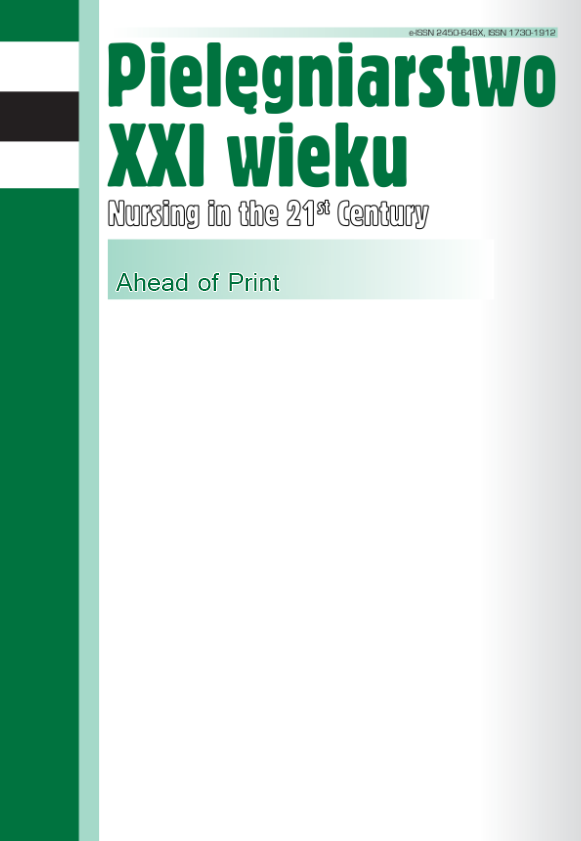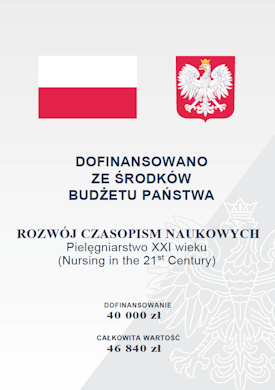Proces pielęgnowania pacjenta po zabiegu PCI CTO z wykorzystaniem PulseCath iVAC 2L na podstawie klasyfikacji ICNP®
DOI:
https://doi.org/10.12923/pielxxiw-2025-0016Słowa kluczowe:
opieka pielęgniarska, przezskórna interwencja wieńcowa (PCI), przewlekła całkowita okluzja (CTO), PulseCath iVAC2LAbstrakt
Aim. The aim of the study was to present the nursing process of a patient after PCI CTO using the PulseCath iVAC 2L device, based on the International Classification of Nursing Practice (ICNP®) classification.
Material and methods. The study was based on an individual case study, using a nursing interview, observation, analysis of medical records and measurement of basic vital signs. It was conducted in June 2024 in a hospital setting, after obtaining the patient’s consent. The observation lasted 5 days.
Results. The patient, a 79-year-old man with coronary artery disease, underwent PCI CTO using the PulseCath iVAC 2L device. The procedure was successful and the patient did not experience any serious complications. The patient was monitored after the procedure and his health condition improved. Before and after the procedure, an improvement in haemodynamic parameters was observed.
Conclusions. The use of the ICNP® classification allowed for a holistic approach to the patient care process, providing systematic diagnosis and planning of nursing interventions. The key role of the nursing staff was to monitor the patient’s condition, manage pain and prevent complications, which contributed to improving the patient’s quality of life after the procedure.
Bibliografia
1. Tsao CW, Aday AW, Almarzooq ZI, et al. Heart disease and stroke statistics-2022 update: a report from the american heart association. Circulation. 2022;145(8):e153-e639. https://doi.org/10.1161/CIR.0000000000001052
2. Martin SS, Aday AW, Almarzooq ZI, et al. Heart disease and stroke statistics: a report of us and global data from the american heart association. Circulation. 2024;149(8):e347-e913. https://doi.org/10.1161/CIR.0000000000001209
3. Farag M, Egred M. CTO in contemporary PCI. Curr. Cardiol. Rev. 2022;18(1):e310521193720. https://doi.org/10.2174/1573403X17666210531143519
4. Panuccio G, Abdelwahed YS, Carabetta N, et al. Clinical and procedural outcomes of IVUS-guided vs. angiography-guided CTO-PCI: A systematic review and meta-analysis. J. Clin. Med. 2023;12(15):4947. https://doi.org/10.3390/jcm12154947
5. Azzalini L, Karmpaliotis D, Santiago R, et al. Contemporary issues in chronic total occlusion percutaneous coronary intervention. JACC Cardiovasc. Interv. 2022;15(1):1-21. https://doi.org/10.1016/j.jcin.2021.09.027
6. Abdelwahed YS, Blum E, Landmesser U, et al. CT-guided CTO-PCI overcoming bypass surgery-induced native coronary artery tenting. J. Invasive. Cardiol. 2022;34(6):E486-E487. https://doi.org/10.25270/jic/21.00432
7. Lee SW, Lee PH, Ahn JM, et al. Randomized trial evaluating percutaneous coronary intervention for the treatment of chronic total occlusion. Circulation. 2019;139(14):1674-1683. https://doi.org/10.1161/CIRCULATIONAHA
8. Munirwan H, Kusyanto FA, Zanisa Z, et al. Chronic total occlusion percutaneous coronary intervention (CTO PCI) in an intractable heart failure patient: Is there any benefit? Narra J. 2023;3(2):e140. https://doi.org/10.52225/narra.v3i2.140
9. Van Mieghem NM, Daemen J, Lenzen MJ, et al. The Pulse Cath iVAC 2L left ventricular assist device: conversion to a percutaneous transfemoral approach. EuroIntervention. 2015;11(7):835-839. https://doi.org/10.4244/EIJV11I7A168
10. den Uil CA, Daemen J, Lenzen MJ, et al. Pulsatile iVAC 2L circulatory support in high-risk percutaneous coronary intervention. Euro Intervention. 2017;12(14):1689-1696. https://doi.org/10.4244/EIJ-D-16-00371
11. Cao D, Chandiramani R, Capodanno D, et al. Non-cardiac surgery in patients with coronary artery disease: risk evaluation and periprocedural management. Nat. Rev. Cardiol. 2021;18(1):37-57. https://doi.org/10.1038/s41569-020-0410-z
12. Rolley JX, Rolley JX, Davidson PM, et al. Review of nursing care for patients undergoing percutaneous coronary intervention: a patient journey approach. Journal of Clinical Nursing. 2009;18(17):2394-2405. https://doi.org/10.1111/j.1365¬2702.2008.02768.x
13. Dębska G, Gorzkowicz B, Foryś Z, et al. Continuous professional development of nurses and ICNP® introduction in Poland. Int. J. Occup. Med. Environ. Health. 2020;33(3):353-363. https://doi.org/10.13075/ijomeh.1896.01480
14. Coenen A, Kim TY. Development of terminology subsets using ICNP®. Int. J. Med. Inform. 2010;79(7):530-538. https://doi.org/10.1016/j.ijmedinf.2010.04.003
15. Rabelo-Silva ER, Cavalcanti ACD, Caldas MCRG, et al. Advanced Nursing Process quality: Comparing the International Classification for Nursing Practice (ICNP) with the NANDA-International (NANDA-I) and Nursing Interventions Classification (NIC). J. Clin. Nurs. 2017;26(3-4):379-387. https://doi.org/10.1111/jocn.13387
16. Snoeren M, Verbeek H, Sixma HJ. Standardized nursing language: the development and application of the International Classification for Nursing Practice (ICNP®). J. Clin. Nurs. 2003;12(6):727-732. https://doi.org/10.1046/j.1466-7657.2003.00184.x
Pobrania
Opublikowane
Numer
Dział
Licencja
Prawa autorskie (c) 2025 Autor

Utwór dostępny jest na licencji Creative Commons Uznanie autorstwa 4.0 Międzynarodowe.




